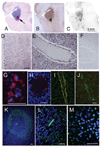Sulfonylurea receptor 1 in the germinal matrix of premature infants
- PMID: 18679166
- PMCID: PMC2647511
- DOI: 10.1203/PDR.0b013e318186e5a9
Sulfonylurea receptor 1 in the germinal matrix of premature infants
Abstract
Germinal matrix (GM) hemorrhage (GMH) is a major cause of mortality and of life-long morbidity from cerebral palsy. GMH is typically preceded by hypoxic/ischemic events and is believed to arise from rupture of weakened veins in the GM. In the CNS, hypoxia/ischemia up-regulate sulfonylurea receptor 1 (SUR1)-regulated NCCa-ATP channels in microvascular endothelium, with channel activation by depletion of ATP being responsible for progressive secondary hemorrhage. We hypothesized that this channel might be up-regulated in the GM of preterm infants at risk for GMH. Here, we studied expression of the regulatory subunit of the channel, SUR1, and its transcriptional antecedent, hypoxia inducible factor 1 (HIF1), in postmortem tissues of premature infants who either were at risk for or who sustained GMH. We found regionally specific up-regulation of HIF1 and of SUR1 protein and mRNA in GM tissues, compared with remote cortical tissues. Up-regulation was prominent in most progenitor cells, whereas in veins, SUR1 was found predominantly in infants who had sustained GMH compared with those without hemorrhage. Our data suggest that the SUR1-regulated NCCa-ATP channel may be associated with GMH, and that pharmacological block of these channels could potentially reduce the incidence of this devastating complication of prematurity.
Conflict of interest statement
Conflict of interest: JMS holds a US patent (# 7,285,574), "A novel non-selective cation channel in neural cells and methods for treating brain swelling".
Figures


Similar articles
-
Molecular mechanisms of microvascular failure in central nervous system injury--synergistic roles of NKCC1 and SUR1/TRPM4.J Neurosurg. 2010 Sep;113(3):622-9. doi: 10.3171/2009.11.JNS081052. J Neurosurg. 2010. PMID: 20035575 Free PMC article. Review.
-
Sequential activation of hypoxia-inducible factor 1 and specificity protein 1 is required for hypoxia-induced transcriptional stimulation of Abcc8.J Cereb Blood Flow Metab. 2012 Mar;32(3):525-36. doi: 10.1038/jcbfm.2011.159. Epub 2011 Nov 16. J Cereb Blood Flow Metab. 2012. PMID: 22086197 Free PMC article.
-
Key role of sulfonylurea receptor 1 in progressive secondary hemorrhage after brain contusion.J Neurotrauma. 2009 Dec;26(12):2257-67. doi: 10.1089/neu.2009.1021. J Neurotrauma. 2009. PMID: 19604096 Free PMC article.
-
Functional coupling between sulfonylurea receptor type 1 and a nonselective cation channel in reactive astrocytes from adult rat brain.J Neurosci. 2003 Sep 17;23(24):8568-77. doi: 10.1523/JNEUROSCI.23-24-08568.2003. J Neurosci. 2003. PMID: 13679426 Free PMC article.
-
Review. SUR1: a unique ATP-binding cassette protein that functions as an ion channel regulator.Philos Trans R Soc Lond B Biol Sci. 2009 Jan 27;364(1514):257-67. doi: 10.1098/rstb.2008.0142. Philos Trans R Soc Lond B Biol Sci. 2009. PMID: 18990670 Free PMC article. Review.
Cited by
-
Sulfonylurea Receptor 1 in Central Nervous System Injury: An Updated Review.Int J Mol Sci. 2021 Nov 2;22(21):11899. doi: 10.3390/ijms222111899. Int J Mol Sci. 2021. PMID: 34769328 Free PMC article. Review.
-
Glibenclamide for the treatment of acute CNS injury.Pharmaceuticals (Basel). 2013 Oct 11;6(10):1287-303. doi: 10.3390/ph6101287. Pharmaceuticals (Basel). 2013. PMID: 24275850 Free PMC article.
-
Tandem insults of prenatal ischemia plus postnatal raised intrathoracic pressure in a novel rat model of encephalopathy of prematurity.J Neurosurg Pediatr. 2011 Dec;8(6):628-39. doi: 10.3171/2011.9.PEDS11174. J Neurosurg Pediatr. 2011. PMID: 22132923 Free PMC article.
-
Ion Channel Dysregulation Following Intracerebral Hemorrhage.Neurosci Bull. 2024 Mar;40(3):401-414. doi: 10.1007/s12264-023-01118-6. Epub 2023 Sep 27. Neurosci Bull. 2024. PMID: 37755675 Free PMC article. Review.
-
Molecular mechanisms of microvascular failure in central nervous system injury--synergistic roles of NKCC1 and SUR1/TRPM4.J Neurosurg. 2010 Sep;113(3):622-9. doi: 10.3171/2009.11.JNS081052. J Neurosurg. 2010. PMID: 20035575 Free PMC article. Review.
References
-
- Vergani P, Locatelli A, Doria V, Assi F, Paterlini G, Pezzullo JC, Ghidini A. Intraventricular hemorrhage and periventricular leukomalacia in preterm infants. Obstet Gynecol. 2004;104:225–231. - PubMed
-
- Folkerth RD. Neuropathologic substrate of cerebral palsy. J Child Neurol. 2005;20:940–949. - PubMed
-
- Kadri H, Mawla AA, Kazah J. The incidence, timing, and predisposing factors of germinal matrix and intraventricular hemorrhage (GMH/IVH) in preterm neonates. Childs Nerv Syst. 2006;22:1086–1090. - PubMed
-
- Lou HC. On the pathogenesis of germinal layer hemorrhage in the neonate. APMIS. 1993;40 Suppl:97–102. - PubMed
-
- Levy ML, Masri LS, McComb JG. Outcome for preterm infants with germinal matrix hemorrhage and progressive hydrocephalus. Neurosurgery. 1997;41:1111–1117. - PubMed
Publication types
MeSH terms
Substances
Grants and funding
LinkOut - more resources
Full Text Sources
Other Literature Sources
Medical

